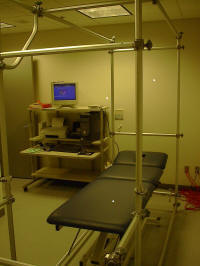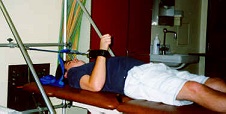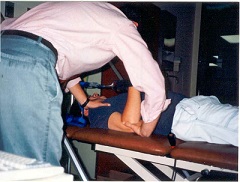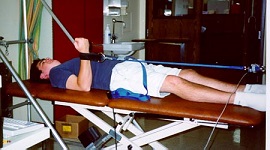
FIXED MYOMETRY
A FIXED
MYOMETRY system normally consists of an electric HIGH/low examination table,
an orthopedic frame, pc or notebook computer with the QMA program, an analog/digital
acquisition device, and various input instruments. The examination table is placed within
and surrounded by the orthopedic frame.
An in-line force transducer (load cell) is
secured to the frame, and a strap or cable is extended to a cuff. The cuff is worn
by the patient (subject), and the the patient is positioned on the examination table
in such a way as to isolate a muscle or muscle group to test. The test is
started, the patient is directed to exert effort, and the resultant data is displayed as a
trace (force/time curve). The analog signal received from the force transducer is
digitized by the acquisition converter in the pc and converted to data within a usable file
structure. Over time additional data may be acquired for longitudinal comparative
analysis. Progress of the patient may be fully documented with
reports that are automatically generated from the information you request.
Fixed Myometry testing permits
stronger extremities, that may exceed 200 lbf, to be assessed
without compromise. Mechanical compromises of testing may
occur when the effort exceeds either the maximum capacity of the
instrument, or the effort permits the fixed point (plane of
resistance) to be moved. Another mechanical compromise of
testing may occur when the effort is small, and the upper capacity
of the instrument large. The maximum error (accuracy) of the
instrument may exceed the effort measured. It is recommended
to utilize instruments (force transducer) that compliment (slightly
exceed) the
anticipated efforts of the patient. Instruments are normally ailable in a range
from 1.1 lbf to 1000 lbf.
Hand and pinch strength and fatigue, and release
Myotonia data may also be assessed and documented.
Critical criteria for test validity is that the acquisition of the data be
accurate and repeatable. Accuracy of an input instrument may be
easily confirmed or improved with "Check & Tweak" - a sub-routine within
QMA. Repeatability or inter-rater reliability may be improved when
each member of a study group is trained and utilize the same techniques and
methodology when testing a patient.
The following are photos of QMA basic setup, assessing equipment and various
tests in process.


QMA Testing Area Setup /
Double Click on Photo to Enlarge
WalSlide / Wall Mount Unit



Testing Elbox Extension
Testing Elbox Extension Stablized Testing Elbow Flexion

Testing Knee Flexion Stabilized
Testing Ankle Dorsiflexion Stabilized
The QMA System utilizes a remote switch that permits the testing
healthcare professional to remain in contact with the patient, to
stabilize the
patient during testing; moving from test to test as each test is concluded
satisfactorily.
Instruments are available to assess hand grip, pinch (key, tip and
palmar, and specialty tests; such as tongue strength, Lip bite and
Jaw / Bite Strength
for Speech
Pathology or the diagnosis of Bulbar ALS.
When the visit is finished, a report may be generated that
documents the efforts of the patient, compares previous muscles
tested in a previous visit, and calculates an expected amount for
each muscle - based on age, gender and BMI.
Click for an example of a
Patient Progress & Evaluation Report.
Other
Input Instruments include:
1. Hand Held
Myometry with integrated Remote Switch
2.
Hand Dynamometer with
analog output - Grip Strength
3.
Pinch Dynamometer with analog output - Pinch - Tip, Key, Palmar
4. IOPI Tongue Strength
Appliance - integrated into QMA
Contact us for additional information - click
here !!
Quantitative Muscle Assessment, "QMA" and
LifeForce are
trademarks of AEVERL MEDICAL, LLC.
All other products mentioned are registered trademarks of their respective
companies.
Questions or problems regarding this web site should be directed to
SPY DR@qmasystem.com.
Copyright 2010 AEVERL MEDICAL, LLC
All rights
reserved. Last modified:
Saturday March 20, 2021.